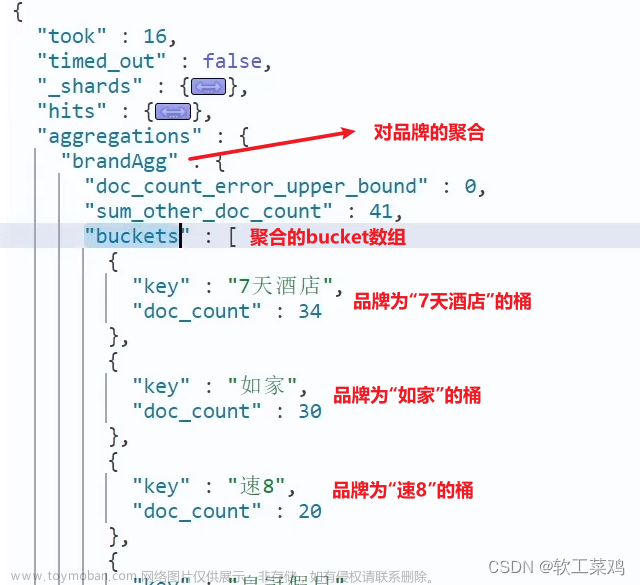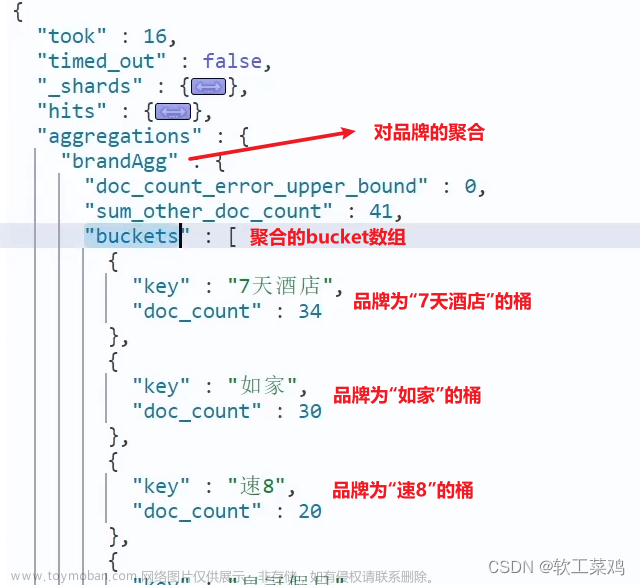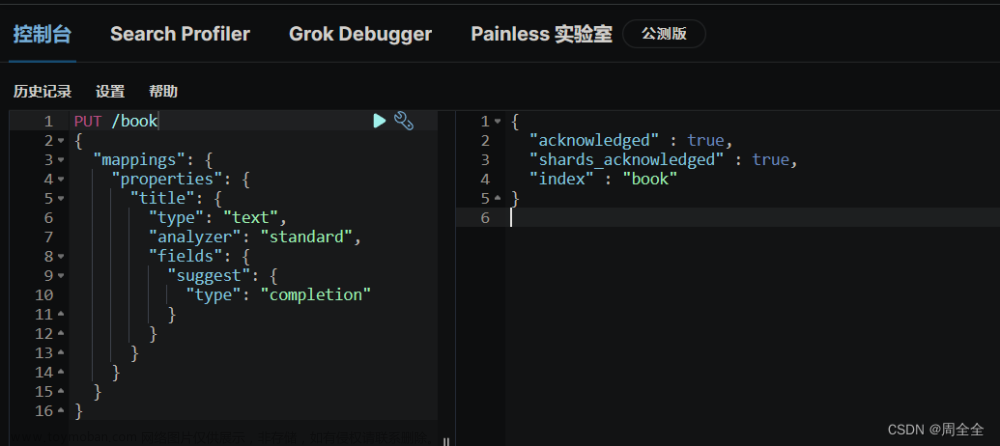elasticsearch 拼音分词器 & 自动补全。
2. 自动补全。
当用户在搜索框输入字符时,我们应该提示出与该字符有关的搜索项,如图。

这种根据用户输入的字母,提示完整词条的功能,就是自动补全了。
因为需要根据拼音字母来推断,因此要用到拼音分词功能。
2.1. 拼音分词器。
要实现根据字母做补全,就必须对文档按照拼音分词。在 GitHub 上恰好有 elasticsearch 的拼音分词插件。地址:https://github.com/medcl/elasticsearch-analysis-pinyin。
课前资料中也提供了拼音分词器的安装包。
安装方式与 IK 分词器一样,分三步。
①解压。
②上传到虚拟机中,elasticsearch 的 plugin 目录。
③重启 elasticsearch
④测试。
详细安装步骤可以参考 IK 分词器的安装过程。
测试用法如下。
POST /_analyze
{
"text": [
"如家酒店还不错"
],
"analyzer": "ik_max_word"
}
结果。
{
"tokens" : [
{
"token" : "ru",
"start_offset" : 0,
"end_offset" : 0,
"type" : "word",
"position" : 0
},
{
"token" : "rjjdhbc",
"start_offset" : 0,
"end_offset" : 0,
"type" : "word",
"position" : 0
},
{
"token" : "jia",
"start_offset" : 0,
"end_offset" : 0,
"type" : "word",
"position" : 1
},
{
"token" : "jiu",
"start_offset" : 0,
"end_offset" : 0,
"type" : "word",
"position" : 2
},
{
"token" : "dian",
"start_offset" : 0,
"end_offset" : 0,
"type" : "word",
"position" : 3
},
{
"token" : "hai",
"start_offset" : 0,
"end_offset" : 0,
"type" : "word",
"position" : 4
},
{
"token" : "bu",
"start_offset" : 0,
"end_offset" : 0,
"type" : "word",
"position" : 5
},
{
"token" : "cuo",
"start_offset" : 0,
"end_offset" : 0,
"type" : "word",
"position" : 6
}
]
}
2.2. 自定义分词器。
默认的拼音分词器会将每个汉字单独分为拼音,而我们希望的是每个词条形成一组拼音,需要对拼音分词器做个性化定制,形成自定义分词器。
elasticsearch 中分词器(analyzer)的组成包含三部分。
-
character filters:在 tokenizer 之前对文本进行处理。例如删除字符、替换字符。
-
tokenizer:将文本按照一定的规则切割成词条(term)。例如 keyword,就是不分词;还有 ik_smart。
term
n. 学期(尤用于英国,学校一年分三个学期);术语;期限;任期;期;词语;措辞;到期;项
vt. 把 … 称为;把 … 叫做
- tokenizer filter:将 tokenizer 输出的词条做进一步处理。例如大小写转换、同义词处理、拼音处理等。
文档分词时会依次由这三部分来处理文档。

声明自定义分词器的语法如下。
在创建索引库时通过 settings 配置自定义的 analyzer(分词器)。
PUT /test
{
"settings": {
"analysis": {
// 自定义分词器。
"analyzer": {
// 分词器名称。
"my_analyzer": {
"tokenizer": "ik_max_word",
"filter": "pinyin"
}
}
}
}
}
PUT /test
{
"settings": {
"analysis": {
// 自定义分词器。
"analyzer": {
// 分词器名称。
"my_analyzer": {
"tokenizer": "ik_max_word",
"filter": "py"
}
},
// 自定义 tokenizer filter。
"filter": {
// 过滤器名称。
"py": {
// 过滤器类型,这里是 pinyin。
"type": "pinyin",
"limit_first_letter_length": 16,
"keep_full_pinyin": false,
"keep_joined_full_pinyin": true,
"none_chinese_pinyin_tokenize": false,
"keep_original": true,
"remove_duplicated_term": true
}
}
}
},
"mappings": {
"properties": {
"name": {
"type": "text",
"analyzer": "my_analyzer",
"search_analyzer": "my_analyzer"
}
}
}
}
{
"acknowledged" : true,
"shards_acknowledged" : true,
"index" : "test"
}
测试。
POST /test/_analyze
{
"text": ["如家酒店还不错"],
"analyzer": "my_analyzer"
}
{
"tokens" : [
{
"token" : "如家",
"start_offset" : 0,
"end_offset" : 2,
"type" : "CN_WORD",
"position" : 0
},
{
"token" : "rujia",
"start_offset" : 0,
"end_offset" : 2,
"type" : "CN_WORD",
"position" : 0
},
{
"token" : "rj",
"start_offset" : 0,
"end_offset" : 2,
"type" : "CN_WORD",
"position" : 0
},
{
"token" : "酒店",
"start_offset" : 2,
"end_offset" : 4,
"type" : "CN_WORD",
"position" : 1
},
{
"token" : "jiudian",
"start_offset" : 2,
"end_offset" : 4,
"type" : "CN_WORD",
"position" : 1
},
{
"token" : "jd",
"start_offset" : 2,
"end_offset" : 4,
"type" : "CN_WORD",
"position" : 1
},
{
"token" : "还不",
"start_offset" : 4,
"end_offset" : 6,
"type" : "CN_WORD",
"position" : 2
},
{
"token" : "haibu",
"start_offset" : 4,
"end_offset" : 6,
"type" : "CN_WORD",
"position" : 2
},
{
"token" : "hb",
"start_offset" : 4,
"end_offset" : 6,
"type" : "CN_WORD",
"position" : 2
},
{
"token" : "不错",
"start_offset" : 5,
"end_offset" : 7,
"type" : "CN_WORD",
"position" : 3
},
{
"token" : "bucuo",
"start_offset" : 5,
"end_offset" : 7,
"type" : "CN_WORD",
"position" : 3
},
{
"token" : "bc",
"start_offset" : 5,
"end_offset" : 7,
"type" : "CN_WORD",
"position" : 3
}
]
}
总结。
如何使用拼音分词器?
-
① 下载 pinyin 分词器。
-
② 解压并放到 elasticsearch 的 plugin 目录。
-
③ 重启即可。
如何自定义分词器?
-
① 创建索引库时,在 settings 中配置,可以包含三部分。
-
② character filter
-
③ tokenizer
-
④ filter
拼音分词器注意事项?
- 为了避免搜索到同音字,搜索时不要使用拼音分词器。
字段在创建倒排索引时应该用 my_analyzer 分词器。
字段在搜索时应该使用 ik_smart 分词器。
PUT /test
{
"settings": {
"analysis": {
// 自定义分词器。
"analyzer": {
// 分词器名称。
"my_analyzer": {
"tokenizer": "ik_max_word",
"filter": "py"
}
},
// 自定义 tokenizer filter。
"filter": {
// 过滤器名称。
"py": {
// 过滤器类型,这里是 pinyin。
"type": "pinyin",
"limit_first_letter_length": 16,
"keep_full_pinyin": false,
"keep_joined_full_pinyin": true,
"none_chinese_pinyin_tokenize": false,
"keep_original": true,
"remove_duplicated_term": true
}
}
}
},
"mappings": {
"properties": {
"name": {
"type": "text",
"analyzer": "my_analyzer",
"search_analyzer": "ik_smart"
}
}
}
}
2.3. 自动补全查询。
elasticsearch 提供了 Completion Suggester 查询来实现自动补全功能。这个查询会匹配以用户输入内容开头的词条并返回。为了提高补全查询的效率,对于文档中字段的类型有一些约束。
-
参与补全查询的字段必须是 completion 类型。
-
字段的内容一般是用来补全的多个词条形成的数组。
比如,一个这样的索引库。
// 创建索引库。
PUT test
{
"mappings": {
"properties": {
"title": {
"type": "completion"
}
}
}
}
然后插入下面的数据。
// 示例数据。
POST test/_doc
{
"title": [
"Sony",
"WH-1000XM5"
]
}
POST test/_doc
{
"title": [
"SK-II",
"PITERA"
]
}
POST test/_doc
{
"title": [
"Nintendo",
"switch"
]
}
查询的 DSL 语句如下。
// 自动补全查询。
GET /test/_search
{
"suggest": {
"titleSuggest": {
// 关键字。
"text": "s",
"completion": {
// 补全查询的字段。
"field": "title",
// 跳过重复的。
"skip_duplicates": true,
// 获取前 10 条结果。
"size": 10
}
}
}
}
{
"took" : 305,
"timed_out" : false,
"_shards" : {
"total" : 1,
"successful" : 1,
"skipped" : 0,
"failed" : 0
},
"hits" : {
"total" : {
"value" : 0,
"relation" : "eq"
},
"max_score" : null,
"hits" : [ ]
},
"suggest" : {
"titleSuggest" : [
{
"text" : "s",
"offset" : 0,
"length" : 1,
"options" : [
{
"text" : "SK-II",
"_index" : "test",
"_type" : "_doc",
"_id" : "xceQcIcBAo7LWD6k-sCY",
"_score" : 1.0,
"_source" : {
"title" : [
"SK-II",
"PITERA"
]
}
},
{
"text" : "Sony",
"_index" : "test",
"_type" : "_doc",
"_id" : "xMeQcIcBAo7LWD6k9MBJ",
"_score" : 1.0,
"_source" : {
"title" : [
"Sony",
"WH-1000XM5"
]
}
},
{
"text" : "switch",
"_index" : "test",
"_type" : "_doc",
"_id" : "xseQcIcBAo7LWD6k_8DL",
"_score" : 1.0,
"_source" : {
"title" : [
"Nintendo",
"switch"
]
}
}
]
}
]
}
}
2.4. 实现酒店搜索框自动补全。
现在,我们的 hotel 索引库还没有设置拼音分词器,需要修改索引库中的配置。但是我们知道索引库是无法修改的,只能删除然后重新创建。
另外,我们需要添加一个字段,用来做自动补全,将 brand、suggestion、city 等都放进去,作为自动补全的提示。
因此,总结一下,我们需要做的事情包括。
-
修改 hotel 索引库结构,设置自定义拼音分词器。
-
修改索引库的 name、all 字段,使用自定义分词器。
-
索引库添加一个新字段 suggestion,类型为 completion 类型,使用自定义的分词器。
-
给 HotelDoc 类添加 suggestion 字段,内容包含 brand、business。
-
重新导入数据到 hotel 库。
2.4.1. 修改酒店映射结构。
代码如下。
DELETE /hotel
// 酒店数据索引库。
PUT /hotel
{
"settings": {
"analysis": {
"analyzer": {
"text_analyzer": {
"tokenizer": "ik_max_word",
"filter": "py"
},
"completion_analyzer": {
"tokenizer": "keyword",
"filter": "py"
}
},
"filter": {
"py": {
"limit_first_letter_length": 16,
"type": "pinyin",
"keep_full_pinyin": false,
"keep_joined_full_pinyin": true,
"none_chinese_pinyin_tokenize": false,
"keep_original": true,
"remove_duplicated_term": true
}
}
}
},
"mappings": {
"properties": {
"all": {
"type": "text",
"analyzer": "text_analyzer",
"search_analyzer": "ik_smart"
},
"id": {
"type": "keyword"
},
"address": {
"type": "keyword",
"index": false
},
"brand": {
"type": "keyword",
"copy_to": "all"
},
"business": {
"type": "keyword",
"copy_to": "all"
},
"city": {
"type": "keyword"
},
"location": {
"type": "geo_point"
},
"name": {
"type": "text",
"analyzer": "text_analyzer",
"search_analyzer": "ik_smart",
"copy_to": "all"
},
"pic": {
"type": "keyword",
"index": false
},
"price": {
"type": "integer"
},
"score": {
"type": "integer"
},
"starName": {
"type": "keyword"
},
"suggestion": {
"type": "completion",
"analyzer": "completion_analyzer"
}
}
}
}
2.4.2. 修改 HotelDoc 实体。
HotelDoc 中要添加一个字段,用来做自动补全,内容可以是酒店品牌、城市、商圈等信息。按照自动补全字段的要求,最好是这些字段的数组。
因此我们在 HotelDoc 中添加一个 suggestion 字段,类型为 List<String>,然后将 brand、city、business 等信息放到里面。
代码如下。
package com.geek.elasticsearchgeek.hotel.pojo;
import lombok.AllArgsConstructor;
import lombok.Data;
import lombok.NoArgsConstructor;
import java.io.Serializable;
import java.util.ArrayList;
import java.util.Arrays;
import java.util.Collections;
import java.util.List;
/**
* @author geek
*/
@Data
@AllArgsConstructor
@NoArgsConstructor
public class HotelDoc implements Serializable {
private Long id;
private String name;
private String address;
private Integer price;
private Integer score;
private String brand;
private String city;
private String starName;
private String business;
private String location;
private String pic;
/**
* 排序时的距离值。
*/
private Object distance;
private Boolean bAdvertise;
private List<String> suggestion;
public HotelDoc(Hotel hotel) {
this.id = hotel.getId();
this.name = hotel.getName();
this.address = hotel.getAddress();
this.price = hotel.getPrice();
this.score = hotel.getScore();
this.brand = hotel.getBrand();
this.city = hotel.getCity();
this.starName = hotel.getStarName();
this.business = hotel.getBusiness();
this.location = hotel.getLatitude() + ", " + hotel.getLongitude();
this.pic = hotel.getPic();
// 组装 suggestion。
if (this.business.contains("/")) {
// business 有多个值,需要切割。
String[] split = this.business.split("/");
// 添加元素。
this.suggestion = new ArrayList<>();
this.suggestion.add(this.brand);
Collections.addAll(this.suggestion, split);
} else {
this.suggestion = Arrays.asList(this.brand, this.business);
}
}
}
2.4.3. 重新导入。
重新执行之前编写的导入数据功能,可以看到新的酒店数据中包含了 suggestion。
测试。
GET /hotel/_search
{
"suggest": {
"suggestions": {
"text": "h",
"completion": {
"field": "suggestion",
"skip_duplicates": true,
"size": 10
}
}
}
}
2.4.4. 自动补全查询的 JavaAPI。
之前我们学习了自动补全查询的 DSL,而没有学习对应的 JavaAPI,这里给出一个示例。


而自动补全的结果也比较特殊,解析的代码如下。


2.4.5. 实现搜索框自动补全。
查看前端页面,可以发现当我们在输入框键入时,前端会发起 ajax 请求。

返回值是补全词条的集合,类型为 List<String>。
1)在 com.geek.elasticsearchgeek.hotel.controller 包下的 HotelController 中添加新接口,接收新的请求。
@RequestMapping("/suggestion")
public List<String> getSuggestions(@RequestParam("key") String prefix) {
return this.hotelService.getSuggestions(prefix);
}
2)在 com.geek.elasticsearchgeek.hotel.service 包下的 IhotelService 中添加方法。文章来源:https://www.toymoban.com/news/detail-741032.html
List<String> getSuggestions(String prefix);
3)在 com.geek.elasticsearchgeek.hotel.service.impl.HotelService 中实现该方法。文章来源地址https://www.toymoban.com/news/detail-741032.html
@Override
public List<String> getSuggestions(String prefix) {
// 准备 Request。
SearchRequest searchRequest = new SearchRequest("hotel");
// 准备 DSL。
searchRequest.source().suggest(new SuggestBuilder().addSuggestion(
"suggestions",
SuggestBuilders.completionSuggestion("suggestion")
.prefix(prefix)
.skipDuplicates(true)
.size(10)
));
// 发起请求。
SearchResponse searchResponse = null;
try {
searchResponse = this.restHighLevelClient.search(searchRequest, RequestOptions.DEFAULT);
} catch (IOException e) {
throw new RuntimeException(e);
}
// 解析结果。
Suggest suggest = searchResponse.getSuggest();
// 根据补全查询名称,获取补全结果。
CompletionSuggestion suggestions = suggest.getSuggestion("mySuggestions");
// 获取 options。
List<CompletionSuggestion.Entry.Option> options = suggestions.getOptions();
// 遍历。
List<String> list = new ArrayList<>(options.size());
for (CompletionSuggestion.Entry.Option option : options) {
// 补全的词条。
String text = option.getText().toString();
list.add(text);
}
return list;
}
到了这里,关于elasticsearch 拼音分词器 & 自动补全。的文章就介绍完了。如果您还想了解更多内容,请在右上角搜索TOY模板网以前的文章或继续浏览下面的相关文章,希望大家以后多多支持TOY模板网!














